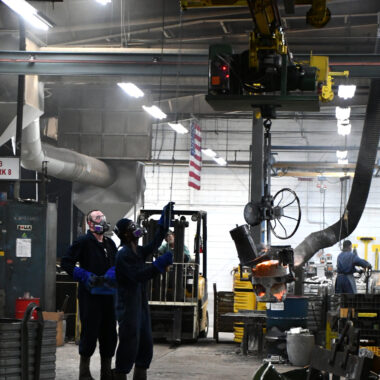Crafting Sparkle: Navigating the World About Aluminum Casting
Crafting Sparkle: Navigating the World About Aluminum Casting
Blog Article
Crafting Perfection: How to Achieve High-Quality Light Weight Aluminum Castings Each Time
In the world of light weight aluminum casting, the pursuit of perfection is a continual trip that calls for a careful method and an eager understanding of the details involved. Accomplishing constant top notch aluminum castings requires a thorough understanding of the processes, from selecting the proper alloy to carrying out precise mold layouts and thoroughly regulating casting parameters.
Comprehending Light Weight Aluminum Casting Processes
Aluminum casting processes, necessary in the manufacturing industry, involve the complex improvement of molten light weight aluminum into strong types with a series of thoroughly regulated actions. Understanding these processes is critical to accomplishing top notch aluminum castings continually - about aluminum casting. The main methods utilized in aluminum spreading are pass away casting, sand spreading, and investment spreading

Each of these processes has its advantages and is selected based on aspects like intricacy, quantity, and preferred surface of the light weight aluminum spreading. about aluminum casting. Comprehending the details of these approaches is vital for manufacturers aiming to produce premium aluminum castings continually
Picking the Right Light Weight Aluminum Alloy
Selecting the ideal light weight aluminum alloy is an essential choice in the production of high-quality aluminum castings. The selection of alloy dramatically affects the residential properties and features of the final product. Various light weight aluminum alloys supply varying levels of strength, rust resistance, machinability, and thermal conductivity. When picking a light weight aluminum alloy for casting, it is vital to think about the details needs of the application to guarantee optimum performance.
Among one of the most typically utilized light weight aluminum alloys for spreading is A356. This alloy uses exceptional castability, high toughness, and great corrosion resistance, making it appropriate for a large range of applications. Alternatively, 6061 aluminum alloy is preferred for its exceptional weldability and great mechanical residential properties. For applications needing high stamina, 7075 light weight aluminum alloy is a popular choice as a result of its exceptional strength-to-weight ratio.
Along with mechanical homes, factors to consider such as price, schedule, and post-casting procedures need to additionally influence the selection of the right aluminum alloy. By carefully examining these variables, suppliers can make certain the manufacturing of high-grade aluminum castings that satisfy the wanted requirements.
Carrying Out Correct Mold And Mildew Design
Developing an effective mold and mildew layout is important for making certain the effective manufacturing of high-quality light weight aluminum spreadings. Proper mold design plays a significant role in achieving the wanted characteristics of the final item. To carry out a successful mold and mildew style, elements such as material flow, cooling down prices, and part geometry must be meticulously thought about.
One key facet of mold and mildew style is ensuring correct filling and solidification of the light weight aluminum within the mold cavity. This entails developing jogger and gating systems that assist in smooth steel circulation and prevent issues such as air entrapment or insufficient filling. In addition, including cooling networks into the mold layout helps control solidification rates and reduce the risk of porosity or contraction issues.

Controlling Casting Parameters

Making Sure Post-Casting High Quality Checks
To preserve the high top quality of aluminum castings, detailed post-casting click here now quality checks are crucial. After the Continue spreading procedure is finished, it is critical to ensure that the last products fulfill the desired specs and requirements.
Dimensional precision is one more vital facet that needs to be verified throughout post-casting quality checks. Dimensions of vital dimensions and tolerances ought to be taken to verify that the castings comply with the required specs. In addition, mechanical homes such as hardness, tensile toughness, and effect resistance may require to be assessed through product screening to make certain that the castings possess the essential toughness and toughness for their designated application.
Conclusion
Finally, attaining high-quality light weight aluminum castings calls for a detailed understanding of the spreading processes, selecting the proper alloy, designing mold and mildews effectively, controlling casting specifications meticulously, and conducting post-casting high quality checks faithfully. By adhering to these steps, suppliers can continually produce aluminum spreadings that meet the greatest criteria of top quality and performance.
Accomplishing consistent top notch aluminum castings requires a comprehensive grasp of the processes, from selecting the proper alloy to executing precise mold styles and carefully managing spreading parameters. The key approaches utilized in aluminum spreading are die casting, sand casting, and financial investment casting.
Financial investment spreading, additionally understood as accuracy casting, involves developing wax patterns that are coated in ceramic to form molds.Selecting the appropriate light weight aluminum alloy is a crucial decision in the production of top quality light weight aluminum castings.Making sure exact control over casting parameters is link crucial for keeping consistency and quality in light weight aluminum spreading manufacturing.
Report this page